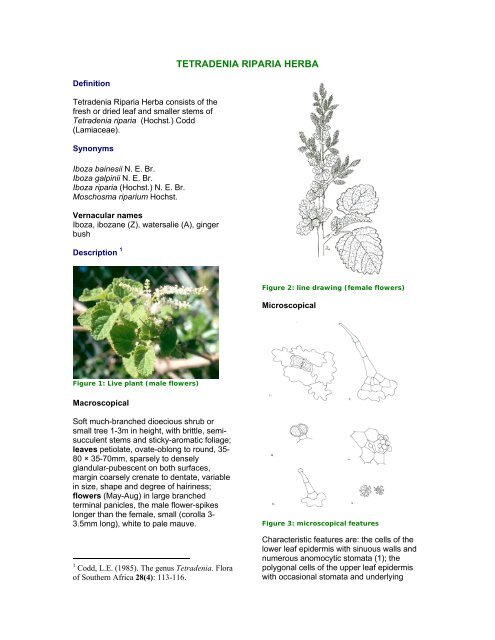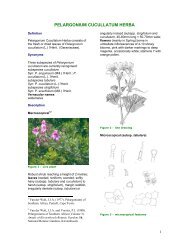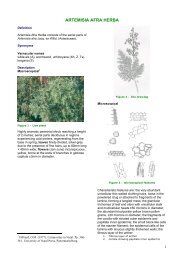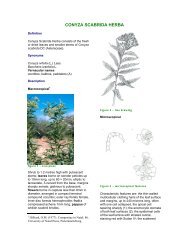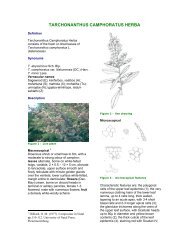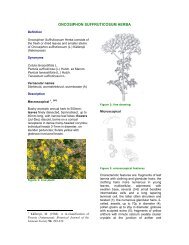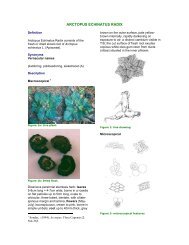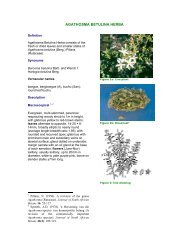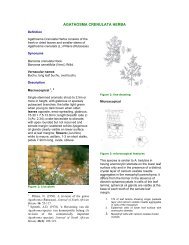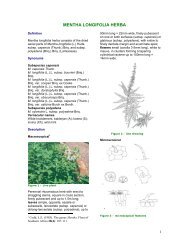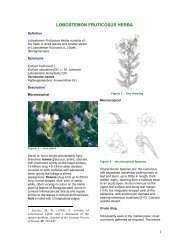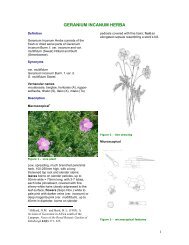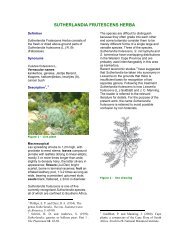TETRADENIA RIPARIA HERBA - PlantZAfrica
TETRADENIA RIPARIA HERBA - PlantZAfrica
TETRADENIA RIPARIA HERBA - PlantZAfrica
Create successful ePaper yourself
Turn your PDF publications into a flip-book with our unique Google optimized e-Paper software.
Definition<br />
Tetradenia Riparia Herba consists of the<br />
fresh or dried leaf and smaller stems of<br />
Tetradenia riparia (Hochst.) Codd<br />
(Lamiaceae).<br />
Synonyms<br />
Iboza bainesii N. E. Br.<br />
Iboza galpinii N. E. Br.<br />
Iboza riparia (Hochst.) N. E. Br.<br />
Moschosma riparium Hochst.<br />
Vernacular names<br />
Iboza, ibozane (Z), watersalie (A), ginger<br />
bush<br />
Description 1<br />
Figure 1: Live plant (male flowers)<br />
Macroscopical<br />
Soft much-branched dioecious shrub or<br />
small tree 1-3m in height, with brittle, semisucculent<br />
stems and sticky-aromatic foliage;<br />
leaves petiolate, ovate-oblong to round, 35-<br />
80 × 35-70mm, sparsely to densely<br />
glandular-pubescent on both surfaces,<br />
margin coarsely crenate to dentate, variable<br />
in size, shape and degree of hairiness;<br />
flowers (May-Aug) in large branched<br />
terminal panicles, the male flower-spikes<br />
longer than the female, small (corolla 3-<br />
3.5mm long), white to pale mauve.<br />
1 Codd, L.E. (1985). The genus Tetradenia. Flora<br />
of Southern Africa 28(4): 113-116.<br />
<strong>TETRADENIA</strong> <strong>RIPARIA</strong> <strong>HERBA</strong><br />
Figure 2: line drawing (female flowers)<br />
Microscopical<br />
Figure 3: microscopical features<br />
Characteristic features are: the cells of the<br />
lower leaf epidermis with sinuous walls and<br />
numerous anomocytic stomata (1); the<br />
polygonal cells of the upper leaf epidermis<br />
with occasional stomata and underlying
palisade layer (4); the numerous glandular<br />
hairs of leaf and stem, of two types: those<br />
with 2-3 celled stalk and unicellular head, up<br />
to 650µ in length, raised on papillae (5),<br />
particularly abundant on main leaf veins and<br />
those having a unicellular stalk and bicellular<br />
head up to 25µ in diameter, filled with<br />
yellow-brown contents (3); the uniseriate<br />
clothing hairs of both leaf surfaces, up to<br />
800µ long, thin-walled, smooth, 2-3 cells<br />
long, with swollen base (2); the microrosettes<br />
of calcium oxalate, 10-12µ in<br />
diameter, in cells of the leaf palisade and<br />
mesophyll (6).<br />
Crude drug<br />
Best collected when required, as material<br />
blackens rapidly after harvesting and dries<br />
with great difficulty; odour pleasant, highly<br />
aromatic, texture soft, foliage extremely<br />
sticky and strongly scented, stems soft and<br />
semi-succulent.<br />
Geographical distribution<br />
Wooded hillsides and stream banks of<br />
coastal KwaZulu/Natal, Mpumalanga and<br />
the Northern Province of South Africa; also<br />
northern Namibia, Angola, Botswana and<br />
east tropical Africa.<br />
Figure 4: distribution map<br />
Quality standards<br />
Identity tests<br />
Thin layer chromatography on silica gel<br />
using as solvent a mixture of toluene:diethyl<br />
ether:1.75M acetic acid (1:1:1). Reference<br />
compound cineole (0,1% in chloroform).<br />
Method according to Appendix 2a.<br />
Rf values of major compounds: 0, 36 (grey);<br />
cineole:0,79 (light blue)<br />
Figure 5: TLC plate<br />
HPLC on C18 column, method according to<br />
Appendix 2b.<br />
Figure 6: HPLC spectrum<br />
Major compounds:<br />
Methanol extract:<br />
Retention times (mins): 3.54; 3.73; 7.42;<br />
9.91<br />
Ethanol (70%) soluble extractive value: not<br />
less than 2.0% (range: 1.96-2.29%),<br />
determined using fresh material (15.0g)<br />
extracted with 200ml 70% ethanol, of which<br />
50ml aliquots were taken (method according<br />
to the BHP 1996).<br />
Purity tests<br />
Assay<br />
Not yet available
Major chemical constituents<br />
1. diterpenes e.g. ibozol 2 , 7 αhydroxyroyleanone,<br />
8 (14), 15sandaracopimaradiene-7α,18-diol<br />
3<br />
2. α-pyrones e.g. umuravumbolide 4, 5 ,<br />
tetradenolide 6 ,<br />
3. essential oil (1.9%) of which the<br />
main components are: α-terpineol<br />
(22.6%), fenchone (13.6%), βfenchyl<br />
alcohol (10.7%), βcaryophyllene<br />
(7.9%) and perillyl<br />
alcohol (6.0%) 7 .<br />
4. phytosterols<br />
Figure 7: chemical constituents<br />
Dosage forms<br />
An aqueous infusion or decoction is taken<br />
orally.<br />
Medicinal uses<br />
2 Zelnik, R., Rabenhorst, E., Matida, A.,<br />
Gottlieb, H.E., Lavie, D and Panizza, S. (1978).<br />
Ibozol, a new diterpenoid from Iboza riparia.<br />
Phytochemistry 17: 1795-1797.<br />
3 Van Puyvelde, L., Lefebvre, R., Mugabo, P., de<br />
Kimpe, N. and Schamp, N. (1987). Active<br />
principles of Tetradenia riparia.II.<br />
Antispasmodic activity of 8 (14), 15sandaracopimaradiene-7α,18-diol.<br />
Planta<br />
Medica 52: 156-158.<br />
4 Van Puyvelde, L. et al.(1979). New α-pyrones<br />
from Iboza riparia. Phytochemistry 18: 1215-<br />
1218.<br />
5 Davies-Coleman, M. and Rivett, D.E.A. (1995).<br />
Structure of the 5,6-dihydro- α-pyrone<br />
umuravumbolide. Phytochemistry 38(3): 791-<br />
792.<br />
6 Van Puyvelde, L. and de Kimpe, N. (1998).<br />
Tetradenolide, an α-pyrone from Tetradenia<br />
riparia. Phytochemistry 49(4): 1157-1158.<br />
7 Campbell, W.E., Gammon, D.W., Smith. P.,<br />
Abrahams, M. and Purves, T. (1997).<br />
Composition and antimalarial activity in vitro of<br />
the essential oil of Tetradenia riparia. Planta<br />
Medica 63: 270-272.<br />
Used throughout its range as a traditional<br />
remedy for cough, respiratory problems,<br />
stomach ache, diarrhoea, dropsy, angina<br />
pectoris, fever, malaria and dengue fever,<br />
yaws, headache, toothache and as an<br />
antiseptic. GR1<br />
Pharmacology/bioactivity<br />
Moderate antimalarial activity of the leaf<br />
essential oil against two strains of<br />
Plasmodium falciparum has been reported 7 .<br />
The diterpene diol 8 (14), 15sandaracopimaradiene-7α,18-diol<br />
has been<br />
shown to possess papaverine-like<br />
antispasmodic activity on methacholine,<br />
histamine and barium chloride-induced<br />
contractions of guinea pig ileum as well as<br />
on noradrenaline-induced contractions of<br />
rabbit aorta 3 .<br />
Leaf extracts (80% ethanol), tested for<br />
antimicrobial and antiviral activity, inhibited<br />
the growth of Staphylococcus aureus,<br />
Candida albicans, Mycobacterium<br />
smegmatis, Microsporum canis,<br />
Trichophyton mentagrophytes and Bacillus<br />
subtilis.<br />
No antiviral activity against Coxsackie virus,<br />
poliovirus (unspecified), measles virus and<br />
Semliki-Forest virus was demonstrated in<br />
these studies 8, 9 . Some of the observed<br />
antimicrobial activity has been attributed to<br />
10, .<br />
the presence of diterpenes 11<br />
8 Vlietinck, A. J. et al. (1995). Screening of a<br />
hundred Rwandese plants for antimicrobial and<br />
antiviral properties. Journal of<br />
Ethnopharmacology 46: 31-47.<br />
9 Boily, Y, and van Puyvelde, L. (1986).<br />
Screening of medicinal plants of Rwanda for<br />
antimicrobial activity. Journal of<br />
Ethnopharmacology 16: 1-13.<br />
10 Van Puyvelde, L. et al. (1986). Active<br />
principles of Tetradenia riparia.I. Antimicrobial<br />
activity of 8 (14), 15-sandaracopimaradiene-<br />
7α,18-diol. Journal of Ethnopharmacology 17:<br />
269-273.<br />
11 Van Puyvelde, L. et al.(1994). In vivo<br />
inhibition of mycobacteria by Rwandese<br />
medicinal plants. Phytotherapy Research 8: 65-<br />
69.
In an in vitro screen for antibacterial activity<br />
of hexane, ethanol and water extracts of<br />
South African plants, no inhibitory activity<br />
against Staphylococcus aureus, Bacillus<br />
subtilis, Escherichia coli or Klebsiella<br />
pneumoniae was demonstrated 12<br />
An in vitro study of the effects of methanolic<br />
extracts of fruit, leaf, stem and root on<br />
skeletal (toad rectus abdominis), smooth<br />
(guinea pig ileum) and uterine (non-pregnant<br />
guinea pig) muscle 13 showed weak activity<br />
on uterine muscle and on smooth muscle<br />
relaxation, but strong to moderate activity on<br />
smooth muscle stimulation and on skeletal<br />
muscle. In the same study, hyper- and<br />
hypotensive effects of the extracts were<br />
tested in vivo in the rabbit, but no activity<br />
was observed in the dose used (5mg/kg IV).<br />
The general toxicity of the extracts was<br />
assessed in vivo in the mouse (dose 1.0g/kg<br />
IP); toxic effects were recorded for root and<br />
fruit extracts but not for leaf or stem extracts.<br />
Insecticidal activity of methanolic extracts<br />
(50mg/ml) of fresh and dried leaf, root and<br />
stem was assessed in vitro, using inhibition<br />
of oviposition in Rhipicephalus<br />
appendiculatus as a measure of acaricidal<br />
activity. None of the extracts was found to<br />
inhibit oviposition. 14<br />
Contraindications<br />
None known<br />
Adverse reactions<br />
There is a single published report<br />
concerning the toxicity of this species 15 and<br />
12 McGaw, L.J., Jager, A.K. and van Staden,<br />
J.V.( 2000). Antibacterial, anthelmintic and antiamoebic<br />
activity of South African medicinal<br />
plants. Journal of Ethnopharmacology 72(1/2):<br />
247-263.<br />
13 Chagnon, M. (1984). General pharmacological<br />
inventory of medicinal plants of Rwanda.<br />
Journal of Ethnopharmacology 12(3): 239-251.<br />
14 Van Puyvelde, L. et al. (1985). Screening of<br />
medicinal plants of Rwanda for acaricidal<br />
activity. Journal of Ethnopharmacology 13(2):<br />
209-215.<br />
15 Bodenstein, J. W. (1977). Toxicity of<br />
traditional herbal remedies. South African<br />
Medical Journal 52:790.<br />
dealing with several cases of poisoning, all<br />
of which occurred in adult males. The data<br />
were collected during 18 years of clinical<br />
practice amongst Zulu communities across a<br />
wide geographical and sociocultural range.<br />
The symptoms included a severe toxic<br />
inflammatory response of mucous<br />
membranes, conspicuous at all body<br />
orifices. In more severe cases this went on<br />
to necrosis and large scale sloughing. A<br />
second symptom was profuse salivation; in<br />
one case an amount in excess of 5 litres of<br />
saliva was produced in 24 hours. In all<br />
cases of terminal illness, urine and stools<br />
consisted of almost pure blood, were dark in<br />
colour and contained shreds of exfoliated<br />
mucous membrane. Patients who were<br />
fatally ill went into anuria during the last 24-<br />
48 hours, but one man recovered after 24<br />
hours of anuria. Most of the patients<br />
presenting with these symptoms had taken<br />
Tetradenia riparia as a cold or flu remedy, in<br />
every case exceeding the traditional dose<br />
and deviating from the accepted method of<br />
administration.<br />
Precautions<br />
No special precautions if used in the<br />
traditional manner<br />
Dosage<br />
To be determined<br />
Copyright in this monograph resides with the authors, the South<br />
African National Biodiversity Institute, the South African Medical<br />
Research Council and the University of the Western Cape. It may<br />
not be reproduced in whole or in part without the written consent of<br />
the copyright holders.


